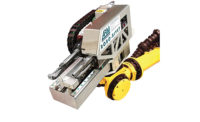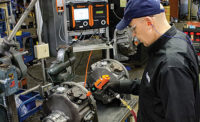Little things not only mean a lot, they can also explain a lot. Consider a spent blind-rivet mandrel, which is only 1 to 2 inches in length, but has tiny markings that provide a wealth of information to veteran rivet-tool-supplier salespeople like Michelle Donath at Yamazen Inc.
“Even though blind riveting is a reliable, proven fastening method, it remains subject to operator error,” explains Donath, manager of the company’s assembly tools group. “End-users often assume that the tool itself is the reason for any installation problem. But, marks at specific locations on the mandrel immediately tell me that it’s not the tool, per se, but other things, like too little hydraulic oil, using the wrong nosepiece or some other explanation is needed as to why the jaws are catching the mandrel too late during installation.”
None of these occasional setbacks, however, can take away from blind-riveting’s decades-long track record of success. The fastening method is used by manufacturers in many industries because it only requires access to one side of an assembly, and it quickly and cost-effectively joins metals, plastics, composites, wood, fiberboard and hollow tubular structures.
Recent advances in both rivets and rivet-insertion tools further enhance its appeal. Multi-grip, structural and custom rivets optimize material support and help assemblers overcome challenges related to the size of predrilled holes. On the tool side, cordless units enable portability and worker comfort, while those featuring process control technology ensure accuracy and repeatability.
A POPular Process
One of the oldest types of fasteners in use, blind rivets have been around for more than a century. The POP rivet was invented in Scotland shortly before World War I. Within 30 years, steel and aluminum break-stem blind rivets were widely used in the U.S. automotive and aircraft industries.
Today, blind rivets are also used in white goods, heavy trucks, tractors and other large assemblies, such as garage doors and prefabricated metal buildings. Besides offering assemblers easy installation and versatility, blind rivets, unlike many other fasteners, cannot be under-torqued, over-torqued or set loose.
“Makers of consumer products are increasingly replacing screws and clips with blind rivets,” says Donath. “Besides being less expensive, the rivets indicate to users that the assembly is not to be taken apart.”
A blind rivet is a two-piece fastener consisting of a headed, hollow rivet body and a solid mandrel (or stem). The body looks like a small tube that is flared on one end. A hole, or core, usually extends the length of the body. The mandrel protrudes from the core and looks like a nail or wire.
After a hole is predrilled or punched through the parts to be joined, the rivet body is inserted. Next, the jaws in the rivet tool’s nosepiece are positioned to properly grip the mandrel. As the tool pulls the mandrel head into the rivet body, the head expands the walls of the rivet radially to fill the hole. This pulling also deforms the rivet body into a load-bearing head or bulb at the end of the rivet, clamping the sheets together. Once the tool reaches a predetermined setting force or tensile load, the mandrel breaks off and either falls to the ground or is moved by vacuum into a collection device.
“Collecting mandrels is essential for FOD [foreign object debris] control, especially at automotive and aerospace plants,” notes Kyle Lang, sales director at Gage Bilt Inc. “Small pieces of loose metal in a car will produce annoying rattling, but in an aircraft they can cause serious structural damage.”
To fasten assemblies made of composite materials, such as plastic, fiberglass and plywood, rivets with different upset styles are used. These rivets produce a trifurcate expansion (like opening flower petals or a peeled banana) on the back side of the material, so the clamping force is spread out.
The typical blind-rivet installation takes about 0.5 second and requires the worker to pull the tool trigger only once, according to Mike Mervis, vice president of sales and marketing at S-B Industries Inc. However, extra-long-rivet installation may require two trigger pulls if the tool’s piston stroke is too short or its traction pulling power is too low.
Regular and Unique Rivets
“The number and types of blind rivets increase every year as companies face the ongoing challenge of performing fast, efficient and reliable assembly,” explains Steve Rogers, director of sales and marketing at Gesipa Fasteners USA. “Because of the rivets’ versatility in a wide range of materials, its industrial use will continue for decades to come.”
Blind rivets come in different types, materials, diameters, grip ranges and head styles. Standard rivets are the most common and least expensive, but are neither watertight nor very strong. Sealed rivets are similar to standard ones, except that the mandrel is completely enclosed, resulting in a watertight seal after installation.
Structural blind rivets retain part of the mandrel after break-off to provide high shear and tensile strength, and vibration resistance. These rivets can be used to complement structural adhesives by securing the parts while the adhesive cures. Multi-grip rivets compact when used on thin material, leaving less material hanging off the back.
Rivet materials include steel, stainless steel, aluminum, copper, brass and plastic. Blind rivets are specified by the rivet and mandrel material (in that order). Matching both materials is always recommended. Industry-specific materials include nylon rivets, which automotive Tier 1s and OEMs use to join molded plastic components, and non-ferrous-alloy Monel and Inconel rivets, which are often specified for aerospace applications.
Standard diameters include 0.094, 0.125, 0.156, 0.188, 0.25 and 0.375 inch. However, manufacturers in newer markets, like alternative energy, are asking for larger-diameter rivets like 0.5 and 0.625 inch.
Each rivet has a specified grip range, which indicates the thickest and thinnest combination of materials the rivet can properly hold together. The wider the range, the greater variation of thicknesses where a single rivet can be used. Multi-grip rivets tend to be more expensive, but do have the widest grip ranges. End-users need to be aware that the maximum grip range is not the length of the rivet body.
Gesipa’s PolyGrip rivets feature several material combinations: aluminum and steel, aluminum and stainless steel, aluminum and Nirosta stainless steel, steel and steel, Monel and stainless steel, and stainless steel and stainless steel. Diameters range from 0.125 to 0.25 inch.
Blind-rivet head styles include dome (standard), oversized dome and flat. The oversized dome head is typically used in softer materials to increase the load-bearing area. A flat head is countersunk for a flush fit.
Gesipa’s Polybulb rivet features a unique large-diameter closing head that gently distributes pressure on sensitive and porous materials. Common automotive applications include joining composite materials when mounting loudspeakers, door modules, body and instrument panels, and seating.
“The closing head protects the rivet from being pulled out of the application, and the locked mandrel keeps the joint safely together even when exposed to high loads,” says Rogers. “In many cases, C-parts, such as washers, are no longer required.”
Rogers adds that the closing head is aesthetically pleasing, with a low profile. The rivet has a wide grip range and produces a tight joint that remains rattle-free when exposed to vibration.
RivetKing ABA all-aluminum blind rivets are brightly polished to improve oxidation resistance and overall aesthetics. A special treatment applied to the rivet surface ensures that the mandrel is encased by the rivet during application. The rivet’s blunt diamond point prevents injury while improving application speed. Designed to meet the IFI-114 grade 11 standard, the rivets are 0.094 to 0.25 inch in diameter, 0.25 to 1.2 inches long and ranked SAE Grade 5 for shear strength (75,000 psi) and tensile strength (100,000 psi).
Several Types of Installation Tools
Installing blind rivets requires a tool that holds the body in place while the mandrel is pulled into or through the rivet. A wide range of manual, pneumatic, hydraulic, hydropneumatic and cordless electric tools are available.
Each tool is furnished with one or more nosepieces to set the most frequently used range of rivet sizes. Special nosepieces are available for particular applications where extra reach into narrow channels or pivot functionality is required. Lang says that Gage Bilt offers hundreds of standard and custom nosepieces for its 50 plus models of rivet tools.
One aerospace company recently required custom nosepieces for its pneumatic rivet tools to better fit into a tight space. Lang says Gage Bilt sent the manufacturer a 3D drawing of the nosepiece for verification, and within two weeks the nosepieces arrived and fit perfectly in the space.
Manual, pliers-like hand tools are generally limited to low-volume applications. They can only install smaller-diameter rivets and those made from softer materials. On the other hand, manual tools are light and versatile.
Automated installation tools, which include pistol-grip rivet guns and in-line or vertical riveters, offer greater pulling capacity and are better able to withstand the kick that is created when a rivet is set. Over the past 20 years, automated tools have also become lighter, more powerful and more ergonomic.
Long-stroke rivet tools further enhance worker ergonomics by delivering power over a longer distance. The result is less end-of-stroke exertion by the tool and operator. This type of tool also transfers power more efficiently on longer rivets or difficult materials.
The pneumatic Lobster R1A1 and R1A2 rivet tools from Yamazen feature a stroke of 19 and 26 millimeters, respectively. Model R1A1 handles steel, stainless steel and aluminum non-structural rivets from 0.094 to 0.188 inch in diameter. The tool weighs 2.2 pounds and produces 2,200 pounds of traction pulling power.
In contrast, model R1A2 weighs 3.8 pounds and produces 4,000 pounds of pulling power. This latter capability enables it to install 0.188- and 0.25-inch-diameter rivets. Battery-powered
versions (R1B1, R1B2) weigh a bit more (3.7 and 4 pounds), but have pulling power (1,900 and 3,200 pounds) without the need for air. All four models feature a safety mechanism whereby the tool only works when its mandrel-collection tank is properly attached.
Traditional pistol-grip tools are designed for use in a horizontal plane. Gesipa’s Taurus C unit features traction-force and stroke sensors that allow for process monitoring of each rivet installation. The electronic module in the tool base generates and analyzes an install curve for each rivet, and can also detect any missing or incorrect rivets, and incorrect hole diameters.
S-B Industries’ rivet tool with process monitoring capabilities is called RivSmart, the latest addition to the company’s Rivdom series. It features a display panel, built-in software that sends monitoring data to an IOS or Android app via Wi-Fi, and a 12-volt lithium-ion battery that generates enough power to install steel rivets up to 0.188-inch diameter.
Other Rivdom tools use a 16- or 20-volt battery, and install steel and stainless steel rivets up to 0.188-, 0.25- or 0.313-inch diameter. When an operator pulls the trigger, an LED light illuminates the application.
One of the newest types of blind-rivet tools is the split-system, where the tool base rests in a backpack while the operator holds the much-lighter pistol grip. Gage Bilt’s pneumatic GB7454SHV split-handle rivet system was originally developed for aerospace assemblers who had to install rivets all day with an 11.5-pound tool held above their heads. Assemblers in the auto and solar-panel industries now use the system as well.
The system features a 3-pound tool and an 8-foot vacuum hose that connects the tool and base. Lang says that a hydraulic version of the system features a 6- or 11-pound tool. Both systems can be equipped with either a vacuum bottle or tube to collect mandrels.
In-line riveters provide an option for vertical riveting applications, and can be hung from a counterbalance, just like an in-line screwdriver. For high-volume applications, rivet tools can be equipped with multiple heads that install more than one fastener at a time. Tools can also be supplied with automatic feeding units that hold several thousand rivets.







